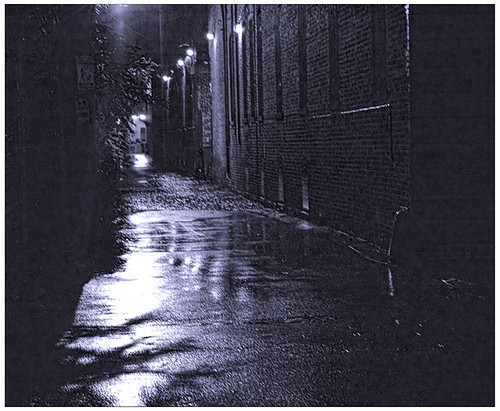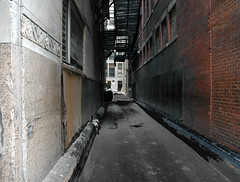Regular readers of this space may remember my little elegy for the alley, about 6 months ago. Some editor at the Tribune agrees with me:
Chicago Tribune | Uncharted territory
...weeklong salute to Chicago's alleys, all 1,900 miles of them, most of any city on the planet.The alley? You ask. The alley??? Yes. The alley! Shaper of Chicago, home of garbage and gardens, danger and Dumpsters, the arena of kickball, hoops and gossip, of scavengers, of neighbors, of rodents.
Chicago is prettier and greener because of its alleys, with much of the messiness of city life moved around back out of sight.
“You can learn just about anything you need to know about a neighborhood in its alleys,” rhapsodizes Dee Brody, a former alley czar for one city ward.
In fact, Chicago's alleys are older than the city itself. They were laid out as part of a 58-block grid in 1830, three years before Chicago was incorporated as a town and seven before it was chartered as a city.
Today's alleys are wonderfully clean and tidy, compared with a century ago.
Bright lights, installed first in the mid-1960s, help cut down on crime, but many alleys are still dicey places to enter in the dark. The large garbage bins that began replacing the old 55-gallon drums in 1984 have drastically reduced the city's rat population -- but, while down, the vermin aren't out.
Although alleys bisect well over 90 percent of Chicago's streets and are integral parts of our lives, very little has been written about them, alley maps are rare, and when's the last time you heard a civic booster trumpeting their virtues?
..
Chicago: Alley capital of the worldChicago, it turns out, has the largest network of alleys in the nation and, almost certainly, in the world. We learned this after calls to dozens of U.S. cities showed none with anywhere near Chicago's 1,900 miles. No single authority keeps comprehensive international statistics about alleys, but the scholars, urban planners and other experts we consulted knew of no other world city anywhere with as many. This chart compares four U.S. cities with extensive alley networks. (Not included are New York, which has relatively few alleys, and Los Angeles, which didn't provide a map of its 800 miles of alleys.) The distinctive alley patterns reflect the development trends in each city.
Chicago's original city plan in 1830 included alleys through every block, a pattern that continues. Today, well over 90 percent of the city's blocks are bisected by alleys.
Apparently, to be a week long series.
Tags: alley, /architecture, /Chicago


